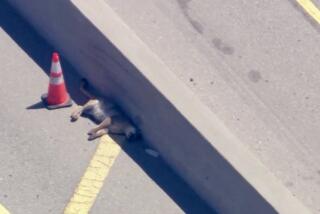Rumbling Botts’ Dots Are Freeway Lifesavers
- Share via
SACRAMENTO — You’re driving down a long, lonely freeway late at night, and your eyes start to droop.
Ka-thump, ka-thump, ka-thump! You’re jolted awake when your car drives over those funny sparkling dots that stick up along the lane dividers.
Saved again by the Botts’ Dots.
Invented more than two decades ago by a state Transportation Department chemist, the dots were not originally intended to keep drowsy drivers awake by making a noise when driven over.
“Our purpose wasn’t really to get a rumble,” explained David Henry of Caltrans’ safety division. “It was to get a reflective lane that is visible day and night, rain or dry. The rumble was a bonus.”
Search for Visible Stripes
Beginning in the 1950s, Caltrans scientists searched for a way to make lane stripes visible in the rain and at night.
“Paint is fine when it’s dry,” traffic engineer Jack Summers said. “But if it’s wet, it’s not visible.”
Elbert Botts, the head of the Caltrans chemical laboratory, invented the dots in the 1950s, and some were placed experimentally on highways.
But the biggest problem was how to fasten the round and rectangular dots to the highway. At first, engineers tried a spike or nail, but that could wreak havoc on tires if the dot broke. Then epoxy glue was invented in the early 1960s.
In 1965, the state began using Botts’ Dots, formally called Raised Pavement Markers, on all highways and freeways. Botts did not live to see his invention become widespread; he died in 1962.
Caltrans has more than 20 million of the markers on highways and spends about $4 million a year putting down about 1.5 million new ones on new highways and as replacements on old highways.
Two Varieties
There are two kinds: non-reflective and reflective. The non-reflective are four inches wide, ceramic and round and come in yellow for the middle of two-lane highways and white to divide lanes going the same way.
The reflective ones come in four shapes: large rectangular, square, small rectangular and octagonal. The white reflective material, similar to reflectors on cars or bicycles, bounces light back to its source.
On most multilane freeways, Caltrans uses four white round non-reflective dots in a row, interspersed every 48 feet with a reflective square, along the painted stripes dividing lanes.
Not many other states use the dots, Summers said. They can’t be used in areas that have snow because snowplow blades will scrape them off the pavement.
Caltrans is experimenting in the Sierra Nevada with grooves dug the lane dividers with the reflectors placed flush with the pavement. Those won’t make a noise when a car drives over them but they will provide the visibility in the dark and rain, Summers said.
The dots are also better than painted stripes because they don’t have to be replaced as often, Henry said. Paint wears out fast and repainting lane stripes on a busy urban freeway is hazardous and expensive, he said.
Reflectives Cost $3.50
The reflective dots, which cost $3.50 each including the labor to install them, last 1 1/2 to 10 years. The non-reflective dots, which cost $1.50 installed, last 10 to 15 years, he said.
There are half a dozen firms in the state that do nothing but install dots on highways and regularly bid for state road contracts, Henry said. Those firms put epoxy on the markers and use a Go-Kart to drive along the stripe and put down the dots.
Henry said the state doesn’t know how many sleepy drivers’ lives might have been saved by the dots, but it does know they work to wake them up, at least temporarily. A research project learned that driving over the dots aroused a dozing driver the first two to four times, but after that, the driver stayed asleep, he said.
“This is an unintended benefit--if the person has the sense to realize, ‘I can’t go any further’ and pulls over,” Henry said.
Summers said the dots also cut down on lane shifting because some people don’t like the noise or fear it will damage their tires or alignment.
Cities use a variation of the dots, in blue, to mark the locations of fire hydrants.










